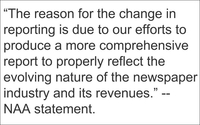Commentary
What If A Major Medium Became Even More Opaque -- And Nobody Cared
- by Joe Mandese @mp_joemandese, January 2, 2014

The first part of that statement would be bad enough. The second part would raise questions about the vitality and the relevance of that medium, altogether. But that seems to
be what happened back in September, when the Newspaper Association of America quietly announced it was discontinuing its quarterly reporting of newspaper ad revenues, and would now only do it
annually. Even though the NAA stated
the move was intended to provide a “more comprehensive report” on newspaper revenues, it is a step in the wrong direction, and follows a pattern of increasing opacity among major media
trade associations and ad bureaus.
About a decade ago, the Cabletelevision Advertising Bureau began the media trade obfuscation trend by asking the Broadcast Cable Financial Management Association to stop releasing monthly audited reports on cable network ad revenues. In 2006, the BCFM did the same thing for its audited quarterly reports on broadcast network ad revenues.
In both those cases, the trade bureaus said the reports were discontinued in order to retool them and provide better public reporting of ad revenue data.
"We decided it would be better to temporarily suspend the report in its current form until we can make the changes that will restore its value as a benchmarking tool for television advertising rather than to continue providing a report that does not provide the full picture of today's television advertising marketplace,” President-CEO Mary Collins stated when the BCFM suspended the reports. Eight years later, they’re still not being released.
Of the major ad-supported media trade associations, only the Radio Advertising Bureau, the Interactive Advertising Bureau, the magazine industry’s Publishers Information Bureau and the Outdoor Advertising Association of America report audits or compilations of their members revenue data. While the BCFM’s audits have been suppressed, the Television Bureau of Advertising does publish quarterly data broadcast and cable networks, spot broadcast and syndicated TV ad revenue estimates from WPP’s Kantar Media unit.
The truth is that the BCFM’s original statement and the NAA’s recent statement that the reporting needs to be retools to make them more comprehensive are true. The bad news is they haven’t done that. Of the major trade associations that do continue to report ad revenue data, the IAB’s is most comprehensive and transparent, even if we did take a shot at the IAB a while back for not figuring out a way to factor programmatic exchange-based revenues -- yet.
Another truth is that better sources are emerging outside of the conventional trade bureaus, including the programmatic exchange-based marketplace itself, as well as Standard Media Index, which is providing good data on the percentage of agency advertising buys going to various media.
The saddest truth is that the NAA would make this change and that hardly anybody noticed. I only learned about it recently when astute Wall Street media industry analyst, Pivotal Research Group’s Brian Wieser, flagged it for me, exclaiming, “No quarterly newspaper numbers any more! Oh well.”Oh well indeed. At a time when much of the media industry is moving at real-time, the newspaper industry is shifting from quarterly to annual time. Still, that's better than the TV industry, which seems to be operating a decade time, if anytime at all.




Obviously, the print & TV media are either afraid or ashamed of the revenue data. They don't want buyers to know the ugly details. Major advertisers should tell the media that something's rotten in Denmark and they'll withhold investments unless they can learn the truth -- the whole truth -- about the value they're getting for their money.